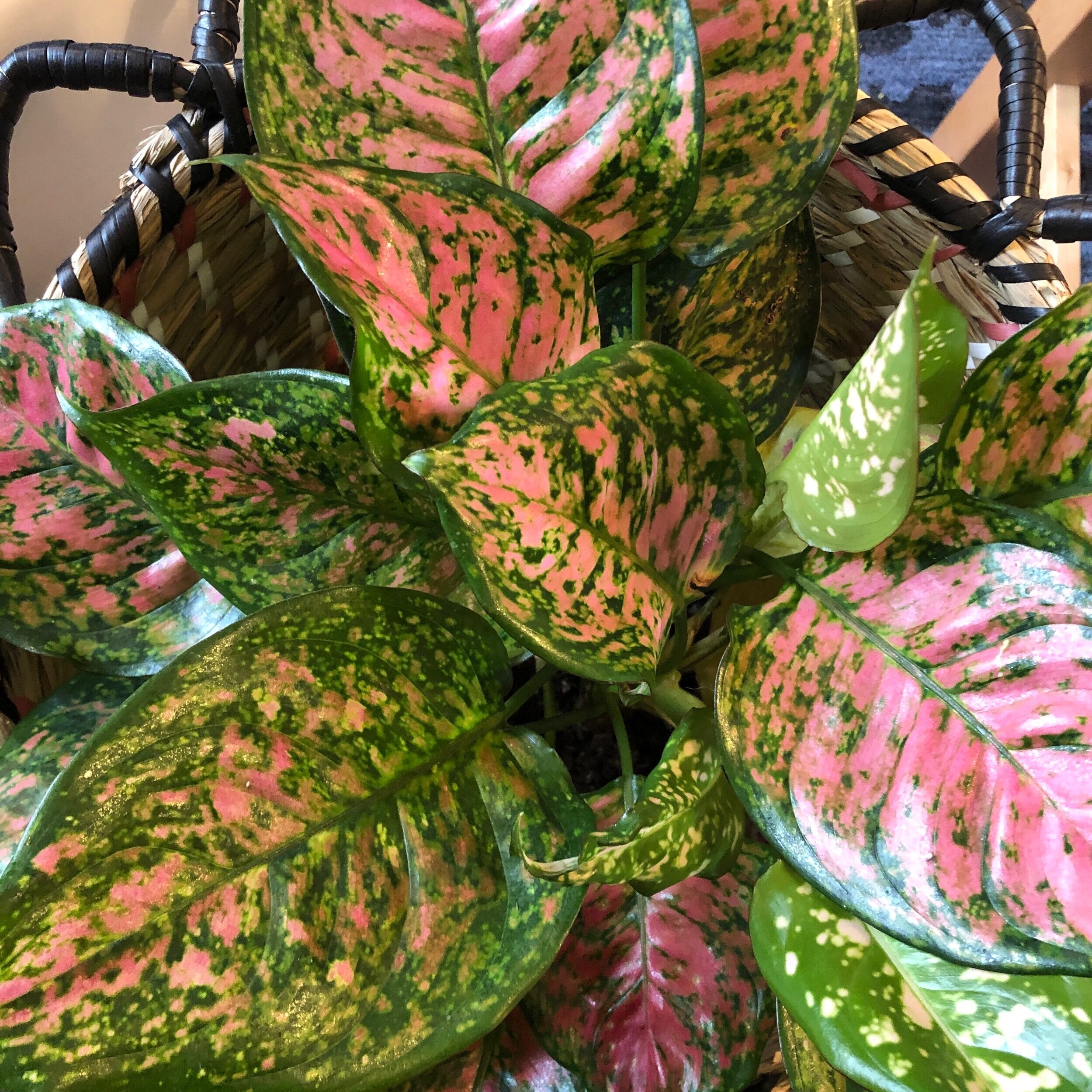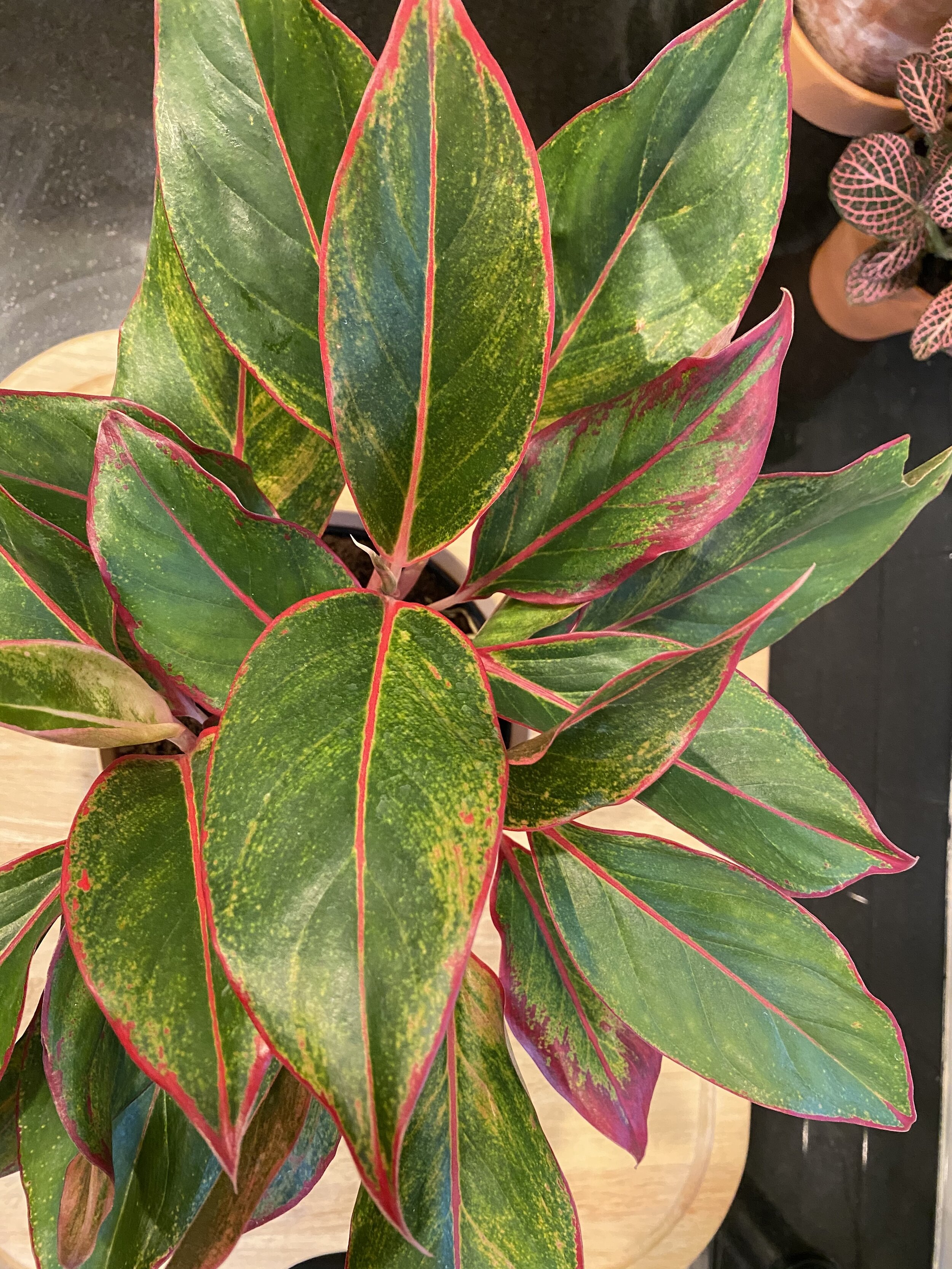About Aglaonema.
Also known as Chinese Evergreen. I don’t know why these beauties are so under-appreciated. Maybe there’s a massive following for Aglaonema of which I am unaware, but from what I see, Aglaonema are a very underrated member of the Aroid family. Pink seems to be the trendy thing in plants right now, and Aglaonema can do pink like nobody’s business. “Sparkling Sarah” has phenomenal light pink stems and patterns, and “Wishes” has hot pink patterning in the leaves. “Etta Rose,” like her name suggests, has a very soft rose tone intermixed with white and green.
Aglaonema are attractive foliage plants to brighten any space, and they don’t ask for much in return. These plants are affordable, low maintenance, striking, and so versatile. They are commonly known as a houseplant that can tolerate low light conditions. This is because Aglaonema are tropical understory plants, their natural environment is shady, warm, and humid. Although they don’t mind low light, they will often grow quickly and even flower when they’re given medium to bright indirect light conditions. It’s important be cautious with the watering when a plant is kept in low light. Often, they will require less water than a plant kept in medium to bright light. An Aglaonema doesn’t appreciate being over-watered.
Aglaonema will love a potting mix formulated specifically for Aroids. Check out the mixture here if you’d like to know more.
Aglaonema “Silver Bay”
This beauty is a companion to my Philodendron Congo Rojo. The two sit together next to my north-facing French doors and mostly keep to themselves. The light is lower, although it is constant throughout the day. “Silver Bay” has a perky, upright growth habit, and the contrast of the green and silver on the leaves is striking. “Silver Bay” can withstand lower light conditions, but as with many plants, you’ll see more growth with medium to bright light. This isn’t a plant for high or direct light conditions. The water should be adjusted based on the light your plant receives. If the light is low, it’ll naturally need less water in most cases. The same could be said for periods when the plant isn’t in active growth. This is another time that it’s best to use caution when watering Aglaonema.
Aglaonema “Etta Rose”
Etta Rose has been moved around a bit in the search for the perfect spot for her to live. This plant has shown her versatility in this process. I think we’ve finally settled on a few feet away from an upstairs west window. Etta Rose has bloomed twice in this location, so I think that’s all the confirmation I need to know that she’s happy there. I received this plant bare root, and I wish I had chosen a larger pot when I dug around in my collection to find the right home for her. As far as her happiness, it seems to be working out swimmingly, but as far as my need to keep up with her watering, it makes a big difference. I feel like I need to water her every few days since she’s in a small, shallow pot with a looser Aroid mix. I’d thought about changing things up by repotting her into a bigger pot with a slightly heavier mix, but Etta Rose is happy and blooming, so I think I’ll keep things as they are for now.
Some Tips:
Etta Rose will appreciate more light than other Aglaonema in my experience. She also, in my experience, doesn't mind being root bound. It’s not a long-term situation to strive for, but Etta Rose has not pouted or wilted like some other plants might in these conditions.
Aglaonema “Sparkling Sarah”
This was the Aglaonema that got me interested in the species. I was and continue to be so fascinated by the colorful foliage. This plant is in one of the darker spots in my home, but it continues to grow steadily. She’s really reliable as far as looking awesome with little maintenance. Luckily for Sparkling Sarah, however, she lives in close proximity to some higher maintenance plants, so she never gets truly looked over. Sarah lives opposite my plant nursery cart, which resides in a sunny west window. Sarah’s corner, however, isn’t able to get much more than a soft glow coming off of that window. I would call her circumstances low light. Since she isn’t taking in a lot of light, She also doesn’t take in water at a high rate. The amazing thing is, even if I do miss a watering, Sarah still looks great. She doesn’t fuss and drop or discolor leaves. This is a great plant for a beginner, or a great Aglaonema gateway plant like she was for me.
Aglaonema “Wishes”
I’m not entirely certain on the identity of this plant. I purchased it without any identification. I was drawn to the color and pattern of the leaves. They are more round than any of my other Aglaonema, and the pink is always eye-catching. I tried putting this plant outdoors this spring on my completely shaded front porch, but that seemed too intense for her somewhat delicate sensibilities. It dropped a couple of leaves, which I didn’t find uncommon for a change in venue, but something about the leaf drop, drooping of healthy leaves, and general peeked appearance of the plant put up some major red flags for me. I moved it back inside to its lower light location directly under an East window and within a few weeks it had started blooming.
Some Tips:
In my experience, Aglaonema can tolerate a repotting without getting fussy. Often, plants that come to us in dense nursery soil inside plastic nursery pots are not going to do well for us as houseplants. The dense soil and non-porous pot are great for growers who need to get these plants to grow quickly, often from cuttings or seeds. Once a plant is switched to a household where it isn’t encountering the heat and humidity of an outdoor growing environment, we need to customize the pot and soil (as the grower did) for optimum health of the plant. This does NOT mean completely stripping the rootball of soil, rinsing it with water, or doubling the size of the pot. Gently removing any soil that falls away freely and increasing the size of the pot by an inch or two for a plant that’s showing roots circling the pot will be sufficient.
Aglaonema “Red Siam”
I found this plant at a big box retailer and was impressed with the red outline on the foliage. I was (and always am) going through an Aglaonema phase, so I had to grab it. This plant really can handle low light. It isn’t demanding and would be an excellent and easy-to-find option for someone who would like to have an Aglaonema houseplant. It handles the indoor conditions well, and as long as it isn’t in direct sun, it can be happy. It isn’t a water hog either. I water it when the soil feels dry on top, but I never need to go through the guessing game “should I or shouldn’t I” water. As always, its better to underwater and add more if necessary, but you won’t find drama here. It’s just a versatile indoor plant.
Some Tips:
I have learned that this plant prefers cooler shade from two failed attempts to place the plant outdoors. The heat didn’t suit this plant in either occasion, but as soon as I put it in regular household temperatures, it began thriving again.
Blooming Aglaonema.
Some Aglaonema have been easy bloomers as houseplants and others just aren’t having it. As with Hoya and nearly any other plant, it’s about getting the light right. If you’re looking to see a (pretty unremarkable) Aglaonema bloom, “Etta Rose” and “Wishes” have been reliable for me, with “Wishes” sometimes having up to three blooms at a time.
Here are a few tips for Aglaonema blooming indoors:
Aglaonema are considered low-light friendly, but blooms aren’t. Boost the light for the best chance of blooms. Go as bright as you can without letting the sun touch the leaves.
If at all possible, choose a specimen with more than one plant in the pot. Not only will it look nicer and fuller, but you’ll have even more chances to bloom your plant. This is why my “Wishes” plant often has more than one bloom at a time.
Make sure you are using a well draining Aroid-friendly soil so the roots aren’t sitting in too much moisture - especially in the bottom third of the pot.
Don’t over-pot your Aglaonema. It’ll focus energy on filling up the pot space with roots and not on building blooms…PLUS, it’s easier to overwater a plant in a big pot.
This one’s just a preference, but terra-cotta pots breathe nicely and help keep plentiful airflow around the root system. Healthy roots equal a healthy plant.
Keep your schedule consistent. Check the plant a couple of days a week for dryness. Only water once the plant is visually dry and dry to the touch.
Clip any yellow or brown leaves so the plant doesn’t spend too much energy feeding a lost leaf.
Be patient. Many plants won’t bloom in their first season with you. In fact, if you’re caring for it properly and giving it plant all the love, the next spring or summer after you purchase is a good time to look for blooms.









